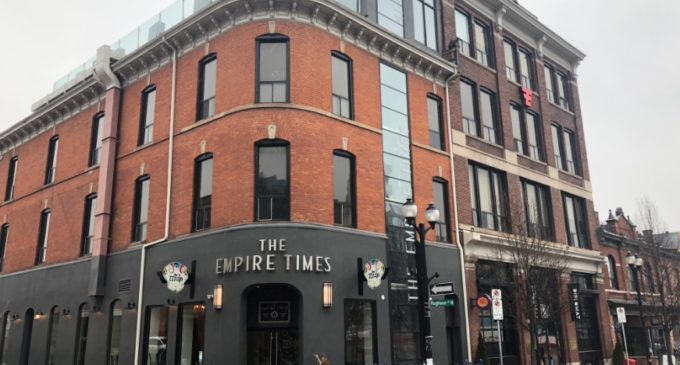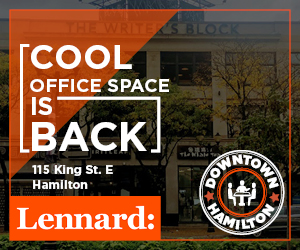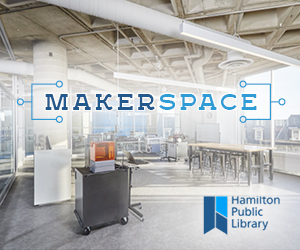Hamilton’s Class A Office Space Half Price Compared to Toronto

Downtown Hamilton mainstay Real Properties is seeing a historic low vacancy in its mall Jackson Square and has attracted anchor tenants in its attached and nearby office towers.
The company has invested in renovating common areas and elevators in 100 King St.W and is converting the seventh storey of the next-door Robert Thompson building into a 4,800-square-foot loft-like space.
“We have spent money because we know good things are happening and we want to be ready to go,” said leasing manager Jocelyne Mainville.“We can design things into a traditional office space to give a unique, funky stamp.”
Mall tenants are investing in their stores and evening and weekend traffic is steadily growing, says Mainville. The mall has a thriving Nations grocery store and renovated cinemas and a bustling farmers market next door. McMaster University moved its continuing education programs and some administrative staff into a 50,000-square-foot pavilion on the east side of the mall at 1 James St. N. that features 14-foot-high open spaces and soaring windows.
There’s excellent optimism thanks to a growing population and more jobs moving downtown, she said. “Hamilton’s downtown is a different place than it was just a few years ago. There is so much happening, that it’s sometimes difficult to keep up with it.”
Joining a growing list of new restaurants, cafes, boutique stores and residential developments is Regus. The global shared workspace provider just opened its first location in downtown Hamilton but is so enthusiastic about the city it is already scouting future sites.
Regus has taken an entire floor – 16,000 square feet – in a 16-storey twin tower office building at King and James streets in the heart of the city.
“I’m excited about Hamilton. I’m a big fan of the city and a big fan of the business and start-up community there,” said Wayne Berger, executive vice-president of IWG Canada, Regus’s parent company.
“We want to be a driver of the continuing evolution in Hamilton. We believe the next two decades will be remarkable in the city.”
He says Hamilton is revitalizing in an authentic way that he admires, pointing to the arrival of restaurants, cafes and gathering spaces.
“There is an independent feel to the downtown neighbourhoods. It’s special because you don’t feel that in every city.”
Hamilton is a great place to embrace risk and pursue a passion or dream, says Berger, and to join the estimated 6 million members of the “contingent workforce” in Canada.
“When people can take risks without mortgaging their grandkids’ future, you will see great experimentation.”
Class-A office space rents for an average of $27.17 per square foot in Hamilton, almost precisely half of the average cost in Toronto.
Hamilton’s affordability compared to the GTA, combined with its urban culture and vibrancy, and its deep innovation ecosystem is attracting start-ups, entrepreneurs, and established companies to its downtown, says Judy Lam, manager of the urban renewal section of the City of Hamilton’s economic development department.
The downtown is particularly attractive to creative companies, including animation powerhouse Pipeline Studios, health and life sciences firms, and a growing roster of FinTech companies, she says.
“Hamilton offers a range of great working space options, everything from brick and beam to contemporary office space to co-working choices. We have a highly diversified economy in Hamilton and our office inventory matches that.”
There is also a broad range of incentives, from façade loans to leasehold improvement loans, offered by the City to bolster investment, said Lam.
“The ongoing growth of employment in our city core is the result of, and builds upon, all the strategic planning and investments contained in our Economic Development Action Plan,” said Glen Norton, director of economic development for the City of Hamilton.
“We are thrilled about and proud of all the well-paying, skilled jobs being created downtown and to see the concentration of innovation and investment being realized in so many sectors.”
Hamilton Health Sciences has become a significant player in Hamilton’s downtown, moving more than 300 administrative staff to several floors in 100 King St.W. and partnering with IBM to open a healthcare innovation hub in 7,000 square feet of open concept space at 1 King St.W.
Hamilton is also leading the way on adaptive reuse projects of heritage architecture.
The Alley is the sixth such project for Hamilton’s Core Urban. It ties together three buildings – two on James Street North and one facing King Street East. The name comes from an alley that once separated the two James Street North brick buildings. Core Urban closed in that alley and added two
floors to the southern building.
Together, they offer 45,000 square feet of space with units ranging from 2,000 to 5,700 square feet. It’s brick and beam construction, with high ceilings and heritage flooring, says Steve Kulakowsky, a partner in Core Urban.
“Tech companies want this style of space, but we also see finance companies or sustainable energy companies. This kind of contemporary heritage space is necessary to attract the talent some companies need.”
Four of eight upper units are available and the three ground-floor commercial units are leased to three restaurant operators.
Some upper floors hadn’t been used in many decades. In fact, one of the buildings was remodelled in the 1980s when an HVAC unit was plunked in the middle of the third floor.
“They thought they would never use it again. That’s the great success of James Street, the upper floors are being used again.”
Core Urban’s two large adaptive reuse projects just around the corner from The Alley on King William Street, heritage office units in The Empire Times and upscale residential rentals at Templar Flats, are adding to Hamilton’s downtown amenities.
Empire Times tenant Huxton Black, a wealth management company, was the first FinTech company to arrive in Hamilton, said chief investment officer Gavin McCrodan.
“We chose Hamilton for our headquarters because of the deep roots established over decades by two of the McMaster alumni founding partners. Although many companies in the Canadian FinTech industry choose Toronto for their home base, we’re excited to be offering services here in a fashion that’s never been done before.”
He said companies are always looking for efficiency gains, making Hamilton “perfectly positioned to be a key consideration for corporate headquarters. The economic climate, cost of living and quality of the talent pool coming from Mohawk and McMaster are all key considerations for business owners. The sentiment for Hamilton has been strengthening for many years now, with no end in sight.”
Fellow Empire Times tenants CASHiQ, which has developed a secure and simple method to optimize yields on cash holdings for high net-worth people, recently located its development office in Hamilton thanks to access to top developers, better availability of office space and a growing fin tech cluster in the city, said Don Martone, president and COO.
Graduates, mainly from McMaster and Mohawk,“prefer Hamilton’s unique ‘techy’ culture, old converted office buildings, outdoor cafes and bars. It’s similar to Queen Street West in Toronto at a more affordable price.”






